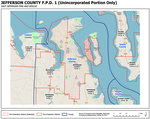The possible annexation of the city of Port Townsend into Jefferson County Fire District 1 for firefighting and emergency medical services would result in higher taxes – somewhere between a low of …
This item is available in full to subscribers.
We have recently launched a new and improved website. To continue reading, you will need to either log into your subscriber account, or purchase a new subscription.
If you had an active account on our previous website, then you have an account here. Simply reset your password to regain access to your account.
If you did not have an account on our previous website, but are a current print subscriber, click here to set up your website account.
Otherwise, click here to view your options for subscribing.
* Having trouble? Call our circulation department at 360-385-2900, or email our support.
Please log in to continue |
|



The possible annexation of the city of Port Townsend into Jefferson County Fire District 1 for firefighting and emergency medical services would result in higher taxes – somewhere between a low of $32 and a high of $205 a year on a $300,000 home in Port Townsend.
City Manager David Timmons said that the amount of the tax increases depends on what the community and City Council decide to do with levy funds, such as possible improvements to housing infrastructure, streets or parks.
The taxes and other issues related to fire annexation were discussed by City Council members Jan. 22. No action was taken.
The question of annexing the city into the fire district is to be put to voters in either August or November.
While Timmons says the maximum should be $205 a year on that typical $300,000 home, Jefferson County Assessor Jeff Chapman estimates the maximum could be $236, not $205.
Residents in the fire district outside city limits would see their taxes remain the same, both Timmons and Chapman agree.
Timmons said it would be far too expensive for the city to fund its own fire and EMS services.
SIMPLER FUNDING, VOTING
The city contracted its fire department to Jefferson County Fire Protection District 1 – better known as East Jefferson Fire Rescue (EJFR) – in 2007 and does not own a fire apparatus or a fire station and does not employ any firefighters. That’s all handled by EJFR now. (The Uptown station in Port Townsend, however, is still used as the backup dispatch center and emergency operations center for the city.)
EJFR operates seamlessly within the city and offers the same level of service in both the city and the fire district via an interlocal agreement, Timmons said.
But the funding and voting mechanism for fire and EMS services is complicated by having the city outside the fire district boundaries – meaning that from a funding perspective, the city and fire district are separate and distinct.
Currently, election issues related to fire services are also separate.
Annexation would simplify the voting process as it relates to fire/EMS, Timmons and others say.
“The other key element here is it creates the ability to coordinate service and deliver services more effectively when it requires some type of voter action or voter input,” Timmons said.
“If you recall … one time we ran the special levy for fire and it failed, and we had to go back out, then we had a joint funding agreement in the interim that created a lot of budgetary issues for us. Then we had to go back to the voters again and then that ballot measure only passed by a handful of votes, and it was very costly to address. That [scenario] would … get eliminated with the annexation,” Timmons said.
If the annexation goes forward, the city would receive the same level of service and same Insurance Service Office (ISO) fire rating that it does now, according to city documents.
MERGER HISTORY
Timmons said the merging of fire districts began years ago. Such mergers are also common nationwide.
“Part of the reason you see a lot of these fire districts merging is because of the need to have an extensive tax base to support the cost of providing the services. And a lot of times, too, these services transcend political boundaries,” Timmons said, as a certain fire district need not be tied to a city limit boundary, for example.
Timmons said it would be far too expensive for the city to fund its own fire and EMS services.
Currently, the city has three council members on a joint fire district board with three elected fire commissioners. The City Council members’ role on that board is advisory and they have no official vote on EJFR policy, Timmons said.
If annexation is approved, the EJFR board would increase from three members to five, with two of those from the city, two from the fire district and one at-large representative.
Three community meetings to discuss possible annexation are planned for late March and early April.
Topics are to include how annexation affects taxpayers, city finances, and options for how the city might use funds that were previously allocated for firefighting and EMS, perhaps redirecting them for another purpose, such as housing infrastructure, parks or roads.
If voters approve annexation, the current interlocal agreement would be maintained until 2020, at which point the annexation would take effect.
City taxpayers would see the impact of annexation in 2020.
Annexation would go into effect if approved by 50 percent of voters, plus one, in two elections: one at the city level and the other at the fire district level.
‘BANKED CAPACITY’
Timmons said state law prohibits voters from lowering a city’s levy authority.
But the City Council could decide to levy less than it is authorized to, which is called “banked capacity.” Timmons added that a future city council could also decide to make use of that capacity.
Timmons said the complexity of annexation and property taxes is difficult to explain. He showed one chart that attempted to illustrate how the taxes work, and said the attorney who created it called it “the rainbow of death.”
“It will be an increase,” Timmons said of property taxes in the event that annexation is approved. “The question is what is the magnitude of the increase. We know that the minimum on a $300,000 home is $32,” Timmons said, with the maximum being a $205 increase. “Now it can range anywhere in between, but council will have the discretion [for the amount above the minimum increase],” Timmons said.
The minimum increase would go directly to the district to improve services districtwide. The city’s special fire levy would be eliminated and no longer be on the tax bill. The city’s EMS levy would go away and be replaced by the district’s EMS levy, which would not change the amount assessed.
The amount that is paid to EJFR currently from the general levy – $908,719 – would remain as levy capacity that could be used for community needs, such as for parks, streets, housing support or other uses.
“There’s a whole slate of things that we could have, but the question is can the voters support that large of an increase [in 2020]?” Timmons said.
“The property tax structure, I think, is probably going to be the most difficult and challenging to explain because we’ve got to say it’s an increase and it’s an increase between ‘x’ and ‘y,’ and that level of increase [above the $32 minimum] will be discretionary on the part of council. So I think that’s why it’s important that we have to have a process to ask the public, ‘What do you want us to do?’” Timmons said.
“I find it really frustrating to explain because it’s so complicated,” Timmons said.
From a levy-rate standpoint, if annexation is approved, the city’s 46-cent fire levy would be eliminated, and as much as 59 cents could be shaved off the city’s general levy (dropping the general levy rate from $1.52 to as low as 92 cents).
However, a fire district levy – somewhere in the range of $1.16-$1.25 – would be collected instead, the exact amount to be determined in 2020.
Another way of looking at how the numbers work: Currently, the city pays $908,719 from the general levy to the fire district for services. The city currently collects a special purpose levy lid lift for fire of $711,557, and also collects an EMS levy of $756,004.
If annexation is approved, the city pays $0 from the general levy to the fire district and the special fire levy is eliminated. In place of those, the fire district levy would collect somewhere between $1.77 million and $1.91 million from the city – the exact amount to be determined in 2020.
The city could decide not to collect the $908,719 for the general levy (banked capacity) or it could collect all or a portion of that money to meet other city needs, hence the potential additional increase in taxes.
The EMS funds are merely swapped out and would not change as a result of annexation.
“It’s included by the fire district. It’s just taking out the middle man, so to speak … its effect is neutral,” Timmons said of the EMS part. (About 80 percent of fire calls are EMS calls, according to EJFR.)
MAYOR: FIREFIGHTERS WANT IT
Mayor Deborah Stinson said the annexation would help sustain the level of fire and EMS services.
“What I’ve been told is they wanted this done like three years ago,” Stinson said of what firefighters told her.
“They’re ready. They feel that they could have a more effective and efficient operation … my understanding from working with the chief and others in the department is they’re ready to go.”